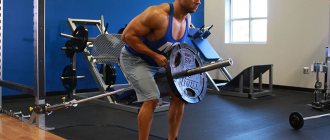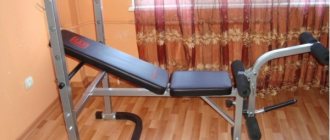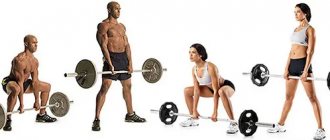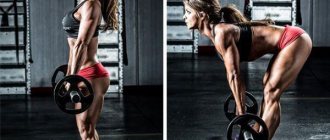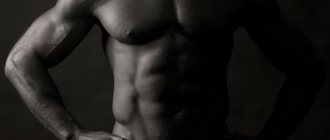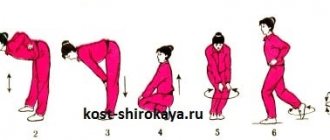Barbell bars are versatile equipment that are an essential tool for strength training. Devices differ in appearance and shape depending on the purpose for which they are used, size and weight. For effective training, it is important for a person to know the features of using this tool.
Rod design
The projectile consists of the following parts:
- neck;
- rotating bushings;
- removable disks;
- locks
The barbell is the most popular sport and allows you to use all the major muscles of a person during training. It allows you to build muscle mass while developing their strength and endurance. The bar is the basis of the barbell and its selection should be given maximum attention. It is selected depending on the group of muscles being trained.
Locks (clamps)
Locks (clamps) are devices that secure the disc to the bar.
- Threaded ones are strong and reliable, but fixation will require additional time.
- Clothespins - quickly fix, but weaken over time and therefore it is necessary to monitor their reliability (especially on dumbbells).
- Locks for Olympic bars are the most reliable and easy to disassemble and reassemble. The disadvantage is the high price.
For collapsible dumbbells, the locks used are the same as for barbells.
Types, weight and other parameters
The parameters of the rod, depending on its name, are given below, namely:
- The Olympic barbell involves the use of a straight bar 2.2 m long . Its diameter is 28 mm, weight is 20 kg, and the diameter of the landing sleeves at the ends is 50 mm. This bar allows you to perform exercises with significant weight, including a wide grip.
- The difference between the barbell for powerlifting is that the diameter has been increased to 29 mm, which increases its rigidity. This makes it possible to lift more weight than using an Olympic barbell.
- The standard barbell has a bar with a diameter of 25 mm. Its weight is 20 kg, and the diameter is the same along its entire length.
- The women's Olympic barbell is similar to the men's barbell, but its length is 2.05 m and its weight is 15 kg with a bar diameter of 25 mm. There are no notches on it.
- The training bar is manufactured according to European or American standards. The difference is in the diameter of the neck: for European – 30.48 mm, for American – 25.4 mm. These diameters are maintained throughout the entire length of the neck. Moreover, the length of the neck in both cases can be 120 and 180 cm.
- The deadlift bar resembles an Olympic barbell, and due to its more flexible bar, it allows you to increase the weight lifted. This bar is not used by the International Powerlifting Federation (IPF).
- The squat bar is also banned in the IPF. A straight bar with a diameter of 32 mm is used, its weight with locks is about 30 kg, the total length should not be more than 2.4 m.
- A barbell with an EZ bar is used to train the arm muscles (biceps and triceps).
- The W-bar barbell is used for the same training as the previous one, but with improved grip conditions.
- A barbell with a T-bar is used to train the back muscles. The load is placed on the lower end of the bar, and the other end is secured. Raising the lower end of the barbell is done on a platform or on a simulator.
- A barbell with a trap bar is used for deadlift training. It is a preparatory tool before training with a straight barbell. Exercises with this bar allow you to reduce the force load on the lower back, since the arms are in a natural position. The handles for gripping the bar are located on the axis of the placed weights. When a person is inside the bar, he takes the barbell by the side handles and lifts the barbell along the optimal trajectory. In this case, the load moves in a straight line, which reduces the load on the joints and spine.
Trap neck
Choosing dumbbells
Dumbbells are divided into several types: solid, stacked, non-separable. Each type is made in different versions.
Stacked and solid dumbbells are suitable for home use. The latter can be made of cast iron, steel, plastic. Composite ones have metal and plastic necks, the discs on them are rubberized, plastic or steel. The method of fastening the disks is a nut.
Stacked dumbbells with a plastic handle are the most convenient option for the home gym - one bar and a small supply of discs are enough. The diagonal of the neck is 25–30 mm, the weight of the set is up to 15 kg.
Non-separable dumbbells have the same design as stacked dumbbells. The only difference is that the weight of the dumbbell can only be changed with special tools. There are also automatic dumbbells, they are very comfortable, but they are much more expensive than classic ones. For example, one dumbbell weighing 24 kg with a weight adjustment of 2.5–24 kg costs about 12 thousand rubles.
For gyms, rows of non-separable dumbbells in 1 kg increments are often chosen. For budget gyms, solid cast iron dumbbells can also be used - they are much cheaper than others, but they make a lot of noise when they fall on the floor and can break. In such a room, it is imperative to take care of shock-absorbing covering, for example, laying rubber mats, linoleum, carpet.
Non-collapsible dumbbells generally have rubberized weights and a steel handle. The handle can be chrome-plated or plastic-coated, with anti-slip notches or smooth, spindle-shaped or straight.
Chromed steel is almost unaffected by external factors: moisture, sunlight, mechanical damage. This is a more hygienic projectile and is easy to clean and wipe down. The benefit of the notches is the anti-slip effect - it is easier to hold the dumbbell during the exercise.
The plastic shell of the handle is usually smooth - the dumbbell can slip out of your hand. Over time, cracks appear in the plastic. For example, as a result of numerous dumbbell falls or careless use.
The weight parts on dumbbells are most often made round and hexagonal. The convenience of the hexagonal shape is that the dumbbells will not roll away from the athlete. They are used in CrossFit - during high-speed exercises, athletes do not have time to monitor the movement of the dumbbell on the floor.
A mandatory attribute in the gym is a rack for storing dumbbells. In order not to select it individually, purchase dumbbell rows. Sets may vary, but a suitable stand is included. In Iron King, these rows are conventionally divided by weight.
The “light” range includes weights from 2 to 9 kg. "Medium" consists of weights of 2–16 kg or 10–19 kg. “Severe” is 9–30 kg in 2 kg increments. From these rows you can form a classic set for an average hall. Combine them with each other. The lungs are used for aerobics and fitness. Medium – for crossfit or group training. Large weights are for gaining weight.
The “heavy” row is the widest, it contains 18 pairs of dumbbells weighing 3–10 kg in 1 kg increments and 10–30 kg in 2 kg increments. The range has everything needed for athletes of different levels.
“Super” – a row of 12 pairs of dumbbells. These are large weights of 18–40 kg in 2 kg increments. “Super” can be used to complement the finished zone if additional weights are needed.
“Pro” is the heaviest and most powerful row. We included dumbbells weighing 20–50 kg. The row will be in demand in a special hall where professional powerlifters, bodybuilders and strongmen train. If your gym is a family entertainment center, then 50 kg dumbbells are unlikely to be needed. As a last resort, purchase more as needed.
Types of vultures
There are the following types:
- straight;
- EZ-neck;
- W-shaped neck;
- T-neck;
- trap neck.
The most common are straight bars. They are used on most rods existing today.
EZ-neck
These include rods such as:
- Olympic;
- for powerlifting;
- standard;
- women's Olympic;
- training;
- for traction;
- for squats.
Straight neck
The main exercises performed using a barbell are given below:
- jerk;
- push;
- various presses;
- deadlift;
- shrugs;
- squats;
- lifting the barbell and others.
Most of the straight bars have a raised notch, which allows you to work with significant weight, because the bar does not tear out of your hands. In this case, the hands do not sweat due to the presence of air in the grooves. To avoid the appearance of calluses during training, you should use gloves.
W-neck
Neck shapes:
- The EZ bar (curved bar) is used on barbells of the same name to perform exercises to develop arm muscles (biceps and triceps). Its use allows you to relieve stress from your forearms and wrists during training. When using this bar, the wrists are in an anatomically more correct position.
- The W-neck is a modified version of the EZ-neck. It provides a close to neutral grip and is used to perform the same exercises.
- The T-bar provides for attaching a load to the bottom of the barbell and is used to perform exercises such as deadlifts, thereby developing the back muscles.
- The trap bar is shaped like a hexagon with handles on the sides. It is used to perform exercises such as deadlifts, shrugs, and bench presses. When performing them, the load falls on the muscles of the legs, back and buttocks.
T-neck
Curved handles on block trainers
Almost all exercises that are performed with a curved bar can be done in a crossover. Knowing what an EZ bar looks like, you can always choose a handle with the same or the most comfortable angle.
On the lower block, forearm curls for biceps, French presses are performed while standing or sitting. By placing a bench next to it and setting the incline you want, you can perform a French bench press.
An exercise such as downward extension of the forearms is performed on the upper block.
Tips for choosing
Depending on the financial potential of a particular person, the following options are possible:
- attending classes in a gym or fitness club following the recommendations of the trainer;
- purchasing the necessary equipment for practicing at home.
In the first case, all questions about choosing a bar will disappear; all equipment will be provided in the required range and at the right time.
In the second case, it is necessary to provide for the solution of the following issues:
- developing or finding a list of exercises to obtain the desired result to improve your body;
- finding a place to conduct classes at home;
- compiling a list of necessary equipment for classes;
- are there the necessary funds to purchase it;
- How will relatives and neighbors react to such activities?
Let's look at these questions in more detail.
Compiling a list of exercises to achieve the desired result to improve your body can be done in two ways:
- independently study the recommendations of trainers or people who have been doing this for a long time, using books or websites on the Internet;
- listen to lectures by specialists or speeches by famous athletes about the types of training and the results they achieved.
According to the selected list of exercises for developing your body, a list of equipment necessary for training is compiled. When choosing a list of exercises using a barbell, you need to determine the type of barbell that is supposed to be used during training.
When practicing powerlifting at home, you will need the following equipment (subject to financial issues being resolved):
- training bar (its size is determined depending on the size of the available room);
- bench press bench;
- barbell rack.
In this case, it is better to choose a barbell with a bar length of 1.8 m and a diameter of 30 or 25 mm. A bar with this length expands the capabilities of the barbell when performing various exercises. With a bar diameter of 25 mm, the barbell can be used not only by yourself, but also by all family members. The set of weights on the bar can be varied.
When purchasing a bar, you need to check its condition, see if it is comfortable for you, if there are any defects on it, or if it is bent. You also need to find out its weight and the maximum possible load that can be allowed when using it (the weight of the bar with discs).
To reduce noise during training, it is better to use rubber-coated MB Barbell discs, manufactured in Petrozavodsk. They will keep the floor in its original form. For a bar with a diameter of 25 mm, the weight of the discs starts from 0.5 kg and ends at 25 kg. The purchase of discs can be done gradually, increasing the weight of the bar to maximum values.
It is advisable not to buy a ready-made barbell, but to assemble it yourself. This will allow you to check every detail of the rod and evaluate the quality of the product.
It is possible to purchase a trap bar at the initial stage of training. This will significantly reduce the cost of purchasing inventory. This type of barbell better develops the thigh muscles when performing the deadlift exercise.
Manufacturer
You should not buy dumbbells and barbells of unknown brands. In terms of price, they can be noticeably more profitable than branded shells, but they have a number of disadvantages. For example, rubberized models may have a very strong odor that does not disappear over time. Using such dumbbells or weights at home is simply impossible. Also, the rubberized coating on the cheapest dumbbells often cracks and peels off.
When choosing dumbbells or barbells, you should pay attention to branded products. Even if they are local or Chinese brands, they will in any case be better than “no-name”. The most famous manufacturers: Alex, Eleiko, FitLogic, Foreman, Hop-Sport, HouseFit, Inter Atletika, Newt, Stein, USA Style, Vadzaari, Joerex, Kettler, Sprinter, Torneo, Stroy-Sport. As well as the world famous Adidas, Reebok and Nike. It is worth noting that the price of their products may be inflated due to the promotion of the brand. It is worth remembering that high-quality set dumbbells or barbells cannot be cheap.
Where to buy and how much does it cost?
Offers for the purchase of various rods and accessories for them are very diverse. You can buy them in sports stores in your city or in online stores. There are quite a lot of offers on Yandex.Market for this type of product.
Here are examples of the cost of rods and their components (the price range is indicated):
- Complete rods can be purchased at prices ranging from 15,000 to 100,000 rubles. The cost depends on the length of the bar and the maximum load on it, its manufacturer.
- Olympic barbell bars can be purchased at prices ranging from 6,000 to 20,000 rubles. (length 220 cm, load on the bar from 200 to 600 kg).
- The cost of straight bars 1.8 m long, depending on its diameter (25-51 mm), ranges from 2,700 to 5,700 rubles. (DFC Training bar chrome. 1800 mm, 51 mm, up to 180 kg).
- EZ-bar and W-bar cost from 1800 to 5000 rubles.
- Trap bars start at RUB 12,000. St. Petersburg LLC “Sam-master” manufactures and sells them at a price of 18,000 rubles.
- The cost of MB Barbell discs weighing from 0.5 to 25 kg ranges from 265 to 3567 rubles. The cost of the disc increases with its weight. Components for the barbells are made by MB Barbell, the American company Body-Solid and others.
Adviсe:
- when performing exercises you need to move from simple to complex;
- you need to increase the weight load gradually;
- try to take into account the tips when selecting a barbell from this article.

